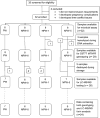Neither folic acid supplementation nor pregnancy affects the distribution of folate forms in the red blood cells of women
- PMID: 24991041
- PMCID: PMC4811356
- DOI: 10.3945/jn.113.189233
Neither folic acid supplementation nor pregnancy affects the distribution of folate forms in the red blood cells of women
Abstract
It is not known whether folate metabolism is altered during pregnancy to support increased DNA and RNA biosynthesis. By using a state-of-the-art LC tandem mass spectrometry technique, the aim of this study was to investigate differences in RBC folate forms between pregnant and nonpregnant women and between nonpregnant women consuming different concentrations of supplemental folic acid. Forms of folate in RBCs were used to explore potential shifts in folate metabolism during early erythropoiesis. Total RBC folate and folate forms [tetrahydrofolate; 5-methyltetrahydrofolate (5-methyl-THF); 4α-hydroxy-5-methyl-tetrahydrofolate (an oxidation product of 5-methyl-THF); 5-formyl-tetrahydrofolate; and 5,10-methenyl-tetrahydrofolate] were measured in 4 groups of women (n = 26): pregnant women (PW) (30-36 wk of gestation) consuming 1 mg/d of folic acid, and nonpregnant women consuming 0 mg/d (NPW-0), 1 mg/d (NPW-1), and 5 mg/d (NPW-5) folic acid. The mean ± SD RBC folate concentration of the NPW-0 group (890 ± 530 nmol/L) was lower than the NPW-1 (1660 ± 350 nmol/L) and NPW-5 (1980 ± 570 nmol/L) groups as assessed by microbiologic assay (n = 26, P < 0.0022). No difference was found between the NPW-1 and NPW-5 groups. We detected 5-methyl-THF [limit of detection (LOD) = 0.06 nmol/L] in all groups and tetrahydrofolate (LOD = 0.2 nmol/L) in most women regardless of methylenetetrahydrofolate reductase genotype. Most women consuming folic acid supplements had detectable concentrations of 5,10-methenyl-tetrahydrofolate (LOD = 0.31 nmol/L). However, there was no difference in the relative distribution of 5-methyl-THF (83-84%), sum of non-methyl folates (0.6-3%), or individual non-methyl folate forms in RBCs across groups. We conclude that although folic acid supplementation in nonpregnant women increases RBC total folate and the concentration of individual folate forms, it does not alter the relative distribution of folate forms. Similarly, distribution of RBC folate forms did not differ between pregnant and nonpregnant women. This trial was registered at clinicaltrials.gov as NCT01741077.
© 2014 American Society for Nutrition.
Conflict of interest statement
Author disclosures: B. A. Hartman, Z. Fazili, C. M. Pfeiffer, and D. L. O’Connor, no conflicts of interest.
Figures


Similar articles
-
[6S]-5-Methyltetrahydrofolate is at least as effective as folic acid in preventing a decline in blood folate concentrations during lactation.Am J Clin Nutr. 2006 Apr;83(4):842-50. doi: 10.1093/ajcn/83.4.842. Am J Clin Nutr. 2006. PMID: 16600937 Clinical Trial.
-
Impact of high-dose folic acid supplementation in pregnancy on biomarkers of folate status and 1-carbon metabolism: An ancillary study of the Folic Acid Clinical Trial (FACT).Am J Clin Nutr. 2021 May 8;113(5):1361-1371. doi: 10.1093/ajcn/nqaa407. Am J Clin Nutr. 2021. PMID: 33675351 Free PMC article. Clinical Trial.
-
Folic acid supplementation and malaria susceptibility and severity among people taking antifolate antimalarial drugs in endemic areas.Cochrane Database Syst Rev. 2022 Feb 1;2(2022):CD014217. doi: 10.1002/14651858.CD014217. Cochrane Database Syst Rev. 2022. PMID: 36321557 Free PMC article.
-
High concentrations of folate and unmetabolized folic acid in a cohort of pregnant Canadian women and umbilical cord blood.Am J Clin Nutr. 2015 Oct;102(4):848-57. doi: 10.3945/ajcn.115.110783. Epub 2015 Aug 12. Am J Clin Nutr. 2015. PMID: 26269367
-
Folic acid and L-5-methyltetrahydrofolate: comparison of clinical pharmacokinetics and pharmacodynamics.Clin Pharmacokinet. 2010 Aug;49(8):535-48. doi: 10.2165/11532990-000000000-00000. Clin Pharmacokinet. 2010. PMID: 20608755 Review.
Cited by
-
Antenatal Multiple Micronutrient Supplementation Compared to Iron-Folic Acid Affects Micronutrient Status but Does Not Eliminate Deficiencies in a Randomized Controlled Trial Among Pregnant Women of Rural Bangladesh.J Nutr. 2019 Jul 1;149(7):1260-1270. doi: 10.1093/jn/nxz046. J Nutr. 2019. PMID: 31006806 Free PMC article. Clinical Trial.
-
Challenges of folate species analysis in food and biological matrices by liquid chromatography-tandem mass spectrometery.Bioanalysis. 2025 May;17(10):681-700. doi: 10.1080/17576180.2025.2515009. Epub 2025 Jun 5. Bioanalysis. 2025. PMID: 40471672 Review.
-
Dietary Folic Acid Alters Metabolism of Multiple Vitamins in a CerS6- and Sex-Dependent Manner.Front Nutr. 2021 Nov 5;8:758403. doi: 10.3389/fnut.2021.758403. eCollection 2021. Front Nutr. 2021. PMID: 34805245 Free PMC article.
-
Ceramide synthase 6 mediates sex-specific metabolic response to dietary folic acid in mice.J Nutr Biochem. 2021 Dec;98:108832. doi: 10.1016/j.jnutbio.2021.108832. Epub 2021 Aug 4. J Nutr Biochem. 2021. PMID: 34358645 Free PMC article.
References
-
- Stover PJ. Physiology of folate and vitamin B12 in health and disease. Nutr Rev. 2004;62:S3–12. discussion S3. - PubMed
-
- De Wals P, Tairou F, Van Allen MI, Uh SH, Lowry RB, Sibbald B, Evans JA, Van den Hof MC, Zimmer P, Crowley M, et al. Reduction in neural-tube defects after folic acid fortification in Canada. N Engl J Med. 2007;357:135–42. - PubMed
-
- Mathews TJ. Trends in spina bifida and anencephalus in the United States, 1991–2006. NCHS Health E-Stat 2009. [cited 2012 November 25]. Available from: http://www.cdc.gov/nchs/data/hestat/spine_anen/spine_anen.htm.
-
- Mills JL, Signore C. Neural tube defect rates before and after food fortification with folic acid. Birth Defects Res A Clin Mol Teratol. 2004;70:844–5. - PubMed
-
- Institute of Medicine. Dietary reference intakes for thiamin, riboflavin, niacin, vitamin B6, folate, vitamin B12, pantothenic acid, biotin, and choline. Washington: National Academy Press; 1998. - PubMed
Publication types
MeSH terms
Substances
Associated data
Grants and funding
LinkOut - more resources
Full Text Sources
Other Literature Sources
Medical

